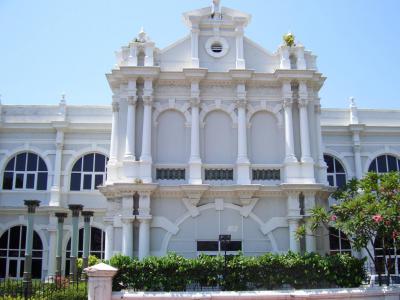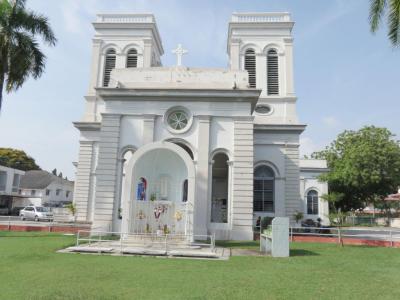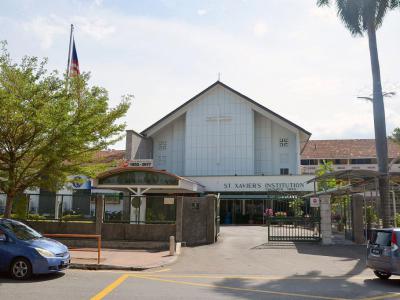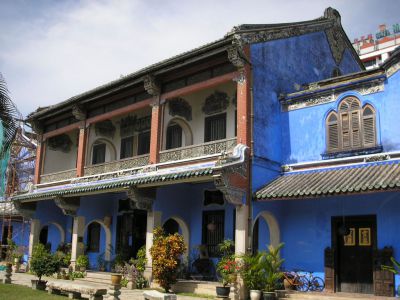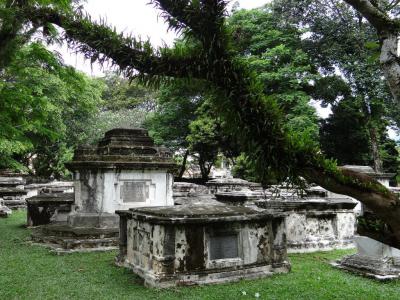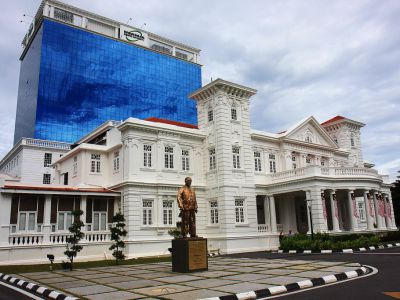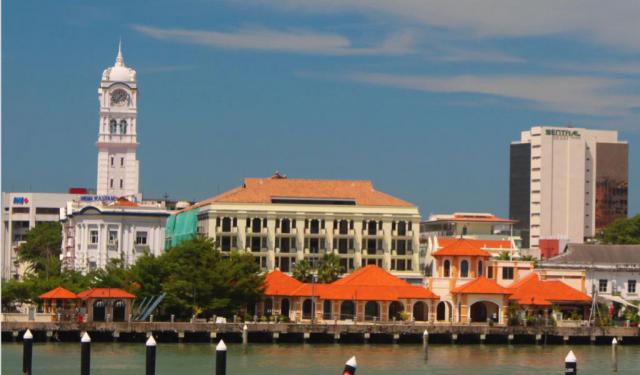
Farquhar Street Walking Tour (Self Guided), George Town
Farquhar Street, a UNESCO World Heritage site since 2008, is a culturally rich thoroughfare in George Town, Malaysia, and home to many interesting historic properties. Let's take a brief journey down this storied street and see what they are.
At the outset of Farquhar stands the impressive Supreme Court building, a symbol of justice and governance in Penang. Just a stone's throw away, the Penang Museum and Art Gallery provides visitors with a glimpse into the region's vibrant history and artistic heritage.
Continuing down the street, you'll encounter the splendid Cathedral of the Assumption, a fine example of Colonial architecture. Nearby, Saint Xavier Institution stands as a testament to the importance of education in Penang's history.
One cannot miss the captivating Cheong Fatt Tze - The Blue Mansion, a beautifully preserved heritage building showcasing the cultural blend of the past. Across the street, the Eastern & Oriental Hotel exudes colonial-era grandeur and luxury.
Farquhar Street also houses the historic Protestant Cemetery, a serene resting place for many of the city's early settlers. Further down the road, the 1930s Runnymede is a three-story building that today accommodates a wealth of leisure and entertainment options.
Lastly, the Wawasan Open University Campus represents the city's commitment to modern education and accessibility.
George Town's Farquhar Street is a captivating blend of historical significance and contemporary vibrancy. A chance to explore its landmarks and experience its charm firsthand will enable you to delve into the diverse culture of Penang. Use it!
At the outset of Farquhar stands the impressive Supreme Court building, a symbol of justice and governance in Penang. Just a stone's throw away, the Penang Museum and Art Gallery provides visitors with a glimpse into the region's vibrant history and artistic heritage.
Continuing down the street, you'll encounter the splendid Cathedral of the Assumption, a fine example of Colonial architecture. Nearby, Saint Xavier Institution stands as a testament to the importance of education in Penang's history.
One cannot miss the captivating Cheong Fatt Tze - The Blue Mansion, a beautifully preserved heritage building showcasing the cultural blend of the past. Across the street, the Eastern & Oriental Hotel exudes colonial-era grandeur and luxury.
Farquhar Street also houses the historic Protestant Cemetery, a serene resting place for many of the city's early settlers. Further down the road, the 1930s Runnymede is a three-story building that today accommodates a wealth of leisure and entertainment options.
Lastly, the Wawasan Open University Campus represents the city's commitment to modern education and accessibility.
George Town's Farquhar Street is a captivating blend of historical significance and contemporary vibrancy. A chance to explore its landmarks and experience its charm firsthand will enable you to delve into the diverse culture of Penang. Use it!
How it works: Download the app "GPSmyCity: Walks in 1K+ Cities" from Apple App Store or Google Play Store to your mobile phone or tablet. The app turns your mobile device into a personal tour guide and its built-in GPS navigation functions guide you from one tour stop to next. The app works offline, so no data plan is needed when traveling abroad.
Farquhar Street Walking Tour Map
Guide Name: Farquhar Street Walking Tour
Guide Location: Malaysia » George Town (See other walking tours in George Town)
Guide Type: Self-guided Walking Tour (Sightseeing)
# of Attractions: 9
Tour Duration: 2 Hour(s)
Travel Distance: 2.4 Km or 1.5 Miles
Author: Maia
Sight(s) Featured in This Guide:
Guide Location: Malaysia » George Town (See other walking tours in George Town)
Guide Type: Self-guided Walking Tour (Sightseeing)
# of Attractions: 9
Tour Duration: 2 Hour(s)
Travel Distance: 2.4 Km or 1.5 Miles
Author: Maia
Sight(s) Featured in This Guide:
- Penang High Court
- Penang State Museum and Art Gallery
- Church of the Assumption
- St. Xavier's Institution
- Cheong Fatt Tze - The Blue Mansion
- Eastern & Oriental Hotel
- Old Protestant Cemetery
- Runnymede
- Wawasan Open University
1) Penang High Court
Founded in 1808, the Penang High Court is the birthplace of Malaysia's judiciary system and remains the apex court in Penang's legal hierarchy. It was moved to its present location at Light Street in 1809, following which the current Palladian-style edifice was constructed between 1901 and 1905, under the direction of John H. McCallum, the Surveyor-General of the Straits Settlements. Its Palladian design is evident in the domed chamber and imposing columns; the original statues and emblems on the building have been removed over time.
The establishment of this institution marked a pivotal moment in Malaya's legal history, heralding the introduction of a modern legal system that would later evolve into Malaysia's current judiciary. Notably, it was within these walls that the first female judge was admitted to the Straits Settlements and Federated Malay States Bars during the 1920s. Additionally, Malaysia's first Prime Minister, Tunku Abdul Rahman, was admitted to the Bar in 1974 within the precincts of the Penang High Court.
In the 2000s, the courthouse underwent renovations, including the addition of a new wing. Adjacent to Light Street, another courthouse accommodating the Magistrates and Sessions Courts was also completed as part of this effort.
The establishment of this institution marked a pivotal moment in Malaya's legal history, heralding the introduction of a modern legal system that would later evolve into Malaysia's current judiciary. Notably, it was within these walls that the first female judge was admitted to the Straits Settlements and Federated Malay States Bars during the 1920s. Additionally, Malaysia's first Prime Minister, Tunku Abdul Rahman, was admitted to the Bar in 1974 within the precincts of the Penang High Court.
In the 2000s, the courthouse underwent renovations, including the addition of a new wing. Adjacent to Light Street, another courthouse accommodating the Magistrates and Sessions Courts was also completed as part of this effort.
2) Penang State Museum and Art Gallery
Established during the late 19th and early 20th centuries, Penang's state-run museum is housed within a Colonial-style building that once served as the premises for the Penang Free School, the first English language public school in the East, dating back to the 1810s. The museum offers a comprehensive exploration of the island's rich history, customs, and traditions, showcasing a diverse array of quality exhibits (including mock-ups of traditional houses) representing its various ethnic groups.
Visitors can immerse themselves in the island's cultural tapestry through an extensive collection of artifacts, including photographs, videos, documents, costumes, furniture, porcelains, and other nicely labeled displays. The museum's upper floor hosts the history gallery, which offers a glimpse into the past with early 19th-century watercolors by Captain Robert Smith, an engineer with the East India Company, and prints depicting landscapes of old Penang – a captivating journey through time.
Tip:
Prior to your visit, please verify if the museum is open to the public.
Visitors can immerse themselves in the island's cultural tapestry through an extensive collection of artifacts, including photographs, videos, documents, costumes, furniture, porcelains, and other nicely labeled displays. The museum's upper floor hosts the history gallery, which offers a glimpse into the past with early 19th-century watercolors by Captain Robert Smith, an engineer with the East India Company, and prints depicting landscapes of old Penang – a captivating journey through time.
Tip:
Prior to your visit, please verify if the museum is open to the public.
3) Church of the Assumption
As you enter this church, a plaque on the left wall commemorates the priests who have served it since its inception. The church's history dates back to 1786 when the first Catholic community in northern Malaya, accompanied by Bishop Arnold Garnault, arrived in Penang and constructed a humble wooden structure on Church Street, naming it the Church of the Assumption. In 1802, the wooden structure was replaced by a brick building with a tower, which served the Catholic community until its relocation to Farquhar Street 1858. Two years later, the current structure was erected by Father Claude Manissol, and the first mass was celebrated there in 1861.
The edifice underwent significant renovations in 1928, including the addition of two wings. In 1955, it was designated the Cathedral of the Diocese of Penang by a Decree of the Vatican, albeit in 2003, the cathedral status was transferred to the Cathedral of the Holy Spirit.
In 2016, the church closed for 14 months for an extensive restoration, reopening on January 1, 2018. Inside, visitors can admire beautiful stained glass panels, life-size statues of saints and the Blessed Virgin Mary, stations of the cross wall hangings, and a grand pipe organ erected in 1916, one of the oldest surviving instruments of its kind still in working condition. With constant maintenance and restoration efforts, this oak, pine, and mahogany instrument with 640 lead and zinc pipes continues to enrich the church's musical tradition.
The church grounds also house the Roman Catholic Penang Diocesan Museum, showcasing the Church's missionary history with artifacts and memorabilia. There is also an art gallery displaying paintings by Father Joseph Reutens.
The edifice underwent significant renovations in 1928, including the addition of two wings. In 1955, it was designated the Cathedral of the Diocese of Penang by a Decree of the Vatican, albeit in 2003, the cathedral status was transferred to the Cathedral of the Holy Spirit.
In 2016, the church closed for 14 months for an extensive restoration, reopening on January 1, 2018. Inside, visitors can admire beautiful stained glass panels, life-size statues of saints and the Blessed Virgin Mary, stations of the cross wall hangings, and a grand pipe organ erected in 1916, one of the oldest surviving instruments of its kind still in working condition. With constant maintenance and restoration efforts, this oak, pine, and mahogany instrument with 640 lead and zinc pipes continues to enrich the church's musical tradition.
The church grounds also house the Roman Catholic Penang Diocesan Museum, showcasing the Church's missionary history with artifacts and memorabilia. There is also an art gallery displaying paintings by Father Joseph Reutens.
4) St. Xavier's Institution
Saint Xavier's Institution (SXI) in Penang holds a distinguished place in Malaysia's educational landscape, tracing its roots back to 1787, soon after the founding of George Town by Captain Francis Light. Initially established as a Malay school by Bishop Arnaud-Antoine Garnault, the institution evolved over the years, eventually becoming known as the Catholic Free School. In 1852, it came under the administration of the De La Salle Brothers (officially named the Institute of the Brothers of the Christian Schools) and was renamed in honor of Francis Xavier, a Spanish Catholic missionary who is revered to this day for his extensive missions in Asia during the 16th century.
The school's relocation to its present grounds at Farquhar Street occurred in 1858; however, during the tumultuous period of the Second World War, the building faced destruction when it was repurposed as a Marine barracks by the Imperial Japanese Navy and subsequently bombed by American forces. With the main building wiped out, a new one, visible today, was completed in 1954.
Throughout its long history, Saint Xavier's Institution has remained committed to providing a well-rounded education that encompasses both academic pursuits and extracurricular activities. A strong emphasis is placed on character development, encouraging students to excel not only in their studies but also in sports, arts, and community engagement.
The school's relocation to its present grounds at Farquhar Street occurred in 1858; however, during the tumultuous period of the Second World War, the building faced destruction when it was repurposed as a Marine barracks by the Imperial Japanese Navy and subsequently bombed by American forces. With the main building wiped out, a new one, visible today, was completed in 1954.
Throughout its long history, Saint Xavier's Institution has remained committed to providing a well-rounded education that encompasses both academic pursuits and extracurricular activities. A strong emphasis is placed on character development, encouraging students to excel not only in their studies but also in sports, arts, and community engagement.
5) Cheong Fatt Tze - The Blue Mansion (must see)
The "Rockefeller of the East", Cheong Fatt Tze, was a poor youth who fled the Second Opium War in Guandong, China. He found his destiny in Southeast Asia. He prospered as an industrialist, politician and philanthropist. His home in George Town was for himself, his eight wives, and six sons.
Cheog Fatt Tze's dream home mansion at 43 Leith Street in George Town is colored indigo blue. The color was chosen for serenity. The house is commonly called the "Blue Mansion." Construction was started in 1897 and completed in 1904. It has two floors, 38 rooms, five granite courtyards, seven staircases, and 220 Gothic louvered windows.
Cheong liked to work from home. The architectural style is eclectic, combining the Chinese concept of bilateral symmetry with western Gothic elements. Features include Chinese porcelains, Stoke-on-Trent floor tiles, Glasgow cast iron, and Art Nouveau stained glass. The building follows the principals of Chinese Feng Shui.
The mansion was bought from Cheong Fatt Tze's descendants in 1989. It was renovated in 1995 and it now operates as a museum and boutique hotel. Tours in English are offered three times daily. A restaurant named "Indigo" is on the first floor. The mansion has been featured in many films and on CNN, BCC, and the History and Discovery channels.
Cheog Fatt Tze's dream home mansion at 43 Leith Street in George Town is colored indigo blue. The color was chosen for serenity. The house is commonly called the "Blue Mansion." Construction was started in 1897 and completed in 1904. It has two floors, 38 rooms, five granite courtyards, seven staircases, and 220 Gothic louvered windows.
Cheong liked to work from home. The architectural style is eclectic, combining the Chinese concept of bilateral symmetry with western Gothic elements. Features include Chinese porcelains, Stoke-on-Trent floor tiles, Glasgow cast iron, and Art Nouveau stained glass. The building follows the principals of Chinese Feng Shui.
The mansion was bought from Cheong Fatt Tze's descendants in 1989. It was renovated in 1995 and it now operates as a museum and boutique hotel. Tours in English are offered three times daily. A restaurant named "Indigo" is on the first floor. The mansion has been featured in many films and on CNN, BCC, and the History and Discovery channels.
6) Eastern & Oriental Hotel
Behold the Eastern & Oriental Hotel, known simply as the 'E&O' by wanderers of yore and modern globetrotters alike. This place has got a charm that's as unique as a pineapple wearing sunglasses. Back in the day, it was like the VIP section of a steamship cruise – only the swanky and sophisticated need apply. We're talking about the jet-setters of the Western world, rubbing elbows with acclaimed writers and aspiring literati, all seeking that exotic Eastern experience.
But hey, time marches on, right? Yet, here we are, in the heart of George Town, and the E&O is still strutting its stuff like it's the belle of the ball in a colonial-era costume drama. It's the living embodiment of a time and place where the gin flowed freely and the afternoon teas were positively scandalous. Life's true pleasures never go out of style here. For over a century, this establishment has been welcoming the world with open arms and a stiff upper lip. Now, after the reopening of the so-called Heritage Wing, they're setting the bar even higher, proving that classic hospitality is still alive and kicking. So, if you're in the mood for a taste of the good life, swing on by the E&O – where luxury meets nostalgia in the most delightful way possible.
But hey, time marches on, right? Yet, here we are, in the heart of George Town, and the E&O is still strutting its stuff like it's the belle of the ball in a colonial-era costume drama. It's the living embodiment of a time and place where the gin flowed freely and the afternoon teas were positively scandalous. Life's true pleasures never go out of style here. For over a century, this establishment has been welcoming the world with open arms and a stiff upper lip. Now, after the reopening of the so-called Heritage Wing, they're setting the bar even higher, proving that classic hospitality is still alive and kicking. So, if you're in the mood for a taste of the good life, swing on by the E&O – where luxury meets nostalgia in the most delightful way possible.
7) Old Protestant Cemetery
Established in 1786 by the British colonial administrators, this site is Penang's oldest Christian cemetery. Beneath a canopy of magnolia trees lie the resting places of Captain Francis Light and numerous others ranging from governors and merchants to sailors and Chinese Christians fleeing the Boxer Rebellion in China, only to succumb to fever in Penang. Notably, the cemetery also houses the tomb of Thomas Leonowens, a young officer who wed Anna, the schoolmistress to the King of Siam, immortalized in the musical "The King and I".
In 2012, the cemetery underwent a comprehensive conservation effort, beginning with the removal of weeds, mosses, and fungi from the headstones. Subsequent phases involved repairing tomb structures, eliminating encroaching trees, and introducing amenities such as walkways, seating areas, and rest spots for visitors. These efforts concluded by the year's end, with significant improvements in visibility and cleanliness. Many tombstones, once obscured by grime and mold, were cleaned to reveal their original white plaster surfaces.
While unconventional, exploring graveyards can be a fascinating experience, offering insights into the lives and histories of those interred. However, visitors should be mindful of the abundance of mosquitoes in the area and come prepared with repellent. Also, keep an eye out for the diverse wildlife that inhabits the cemetery grounds.
In 2012, the cemetery underwent a comprehensive conservation effort, beginning with the removal of weeds, mosses, and fungi from the headstones. Subsequent phases involved repairing tomb structures, eliminating encroaching trees, and introducing amenities such as walkways, seating areas, and rest spots for visitors. These efforts concluded by the year's end, with significant improvements in visibility and cleanliness. Many tombstones, once obscured by grime and mold, were cleaned to reveal their original white plaster surfaces.
While unconventional, exploring graveyards can be a fascinating experience, offering insights into the lives and histories of those interred. However, visitors should be mindful of the abundance of mosquitoes in the area and come prepared with repellent. Also, keep an eye out for the diverse wildlife that inhabits the cemetery grounds.
8) Runnymede
Named after the historic field where King John formalized the Magna Carta, Runnymede comprises a group of buildings situated along George Town’s seafront in Penang. The site gained prominence due to its association with Sir Stamford Raffles, renowned for later founding Singapore, who resided here during his tenure in Penang. In March 1805, Raffles, then serving as an assistant secretary to the new Governor of Penang, married a widow he had met while she was petitioning for a pension from her deceased husband.
Historical records indicate that the original Runnymede was a brick bungalow constructed by Raffles in 1808. It served as the Raffleses' residence until 1810 when it was sold to the British East India Company (EIC) for $4,800 Spanish dollars. Subsequently, the EIC designated it as the lodging for visiting navy captains, until a fire engulfed the building in 1901, leading to its destruction. Following the fire, the surrounding structures were purchased and transformed into a hotel, offering competition to the nearby Eastern & Oriental Hotel.
The main three-story seafront edifice was erected in the 1930s, featuring a grand ballroom on the ground floor and guestrooms on the upper floors. During its heyday in 1935, the Runnymede Hotel hosted weekly cocktail dances and dinner dances, boasting amenities such as a post office, telegraph office, hairdresser, bookstall, reading room, billiard room, railway ticketing office, and a fleet of chauffeured motorcars. During the Second World War, however, the building served as part of a naval and military base.
Historical records indicate that the original Runnymede was a brick bungalow constructed by Raffles in 1808. It served as the Raffleses' residence until 1810 when it was sold to the British East India Company (EIC) for $4,800 Spanish dollars. Subsequently, the EIC designated it as the lodging for visiting navy captains, until a fire engulfed the building in 1901, leading to its destruction. Following the fire, the surrounding structures were purchased and transformed into a hotel, offering competition to the nearby Eastern & Oriental Hotel.
The main three-story seafront edifice was erected in the 1930s, featuring a grand ballroom on the ground floor and guestrooms on the upper floors. During its heyday in 1935, the Runnymede Hotel hosted weekly cocktail dances and dinner dances, boasting amenities such as a post office, telegraph office, hairdresser, bookstall, reading room, billiard room, railway ticketing office, and a fleet of chauffeured motorcars. During the Second World War, however, the building served as part of a naval and military base.
9) Wawasan Open University
Occupying an expansive stretch of coastal land, the campus of Wawasan Open University (WOU) comprises two distinct buildings: the historic Homestead mansion and the contemporary 12-storey Al-Bukhary Building. Dating back to 1919, Homestead exudes colonial charm with its elegant architectural style. According to local legend, Yeap Chor Ee, the benefactor behind its construction, funded the project to obstruct the sea view from his rival's mansion across the road! A striking golden monument honoring him is situated at the entrance.
Established in 2006, WOU holds the distinction of being the sole private institution of its kind in the country. It offers a diverse array of undergraduate and postgraduate programs spanning disciplines such as business, education, information technology, humanities, and social sciences. Notably, the university earned a Tier-5 or "Excellent" rating in the SETARA local university ranking exercises conducted by the Ministry of Education in both 2011 and 2013.
Established in 2006, WOU holds the distinction of being the sole private institution of its kind in the country. It offers a diverse array of undergraduate and postgraduate programs spanning disciplines such as business, education, information technology, humanities, and social sciences. Notably, the university earned a Tier-5 or "Excellent" rating in the SETARA local university ranking exercises conducted by the Ministry of Education in both 2011 and 2013.
Walking Tours in George Town, Malaysia
Create Your Own Walk in George Town
Creating your own self-guided walk in George Town is easy and fun. Choose the city attractions that you want to see and a walk route map will be created just for you. You can even set your hotel as the start point of the walk.
George Town Introduction Walking Tour
Some felt in Malaya that the city of George Town should be renamed Tanjung Penaga ("Cape Penaga"). That was the name of the area where George Town now stands. But the Chinese, British, Muslim, Malay and Indian movers and shakers of the town wisely declined. It might be bad for business.
Captain Francis Light, R. N., came to Tanjung Penaga in 1786. He wanted to set up an entrepôt for... view more
Tour Duration: 2 Hour(s)
Travel Distance: 3.3 Km or 2.1 Miles
Captain Francis Light, R. N., came to Tanjung Penaga in 1786. He wanted to set up an entrepôt for... view more
Tour Duration: 2 Hour(s)
Travel Distance: 3.3 Km or 2.1 Miles
George Town's Historical Religious Buildings
George Town, Malaysia, has much to be proud of when it comes to religious heritage. The city boasts a plethora of wonderful churches, temples, mosques, and other religious sites – each beautifully decorated and with its own unique story. Follow us on this self-guided walk and see some of them up close.
We start at the Acheen Street Mosque. Dating back to the early 19th century, this is one of... view more
Tour Duration: 1 Hour(s)
Travel Distance: 1.8 Km or 1.1 Miles
We start at the Acheen Street Mosque. Dating back to the early 19th century, this is one of... view more
Tour Duration: 1 Hour(s)
Travel Distance: 1.8 Km or 1.1 Miles
The Most Popular Cities
/ view all

